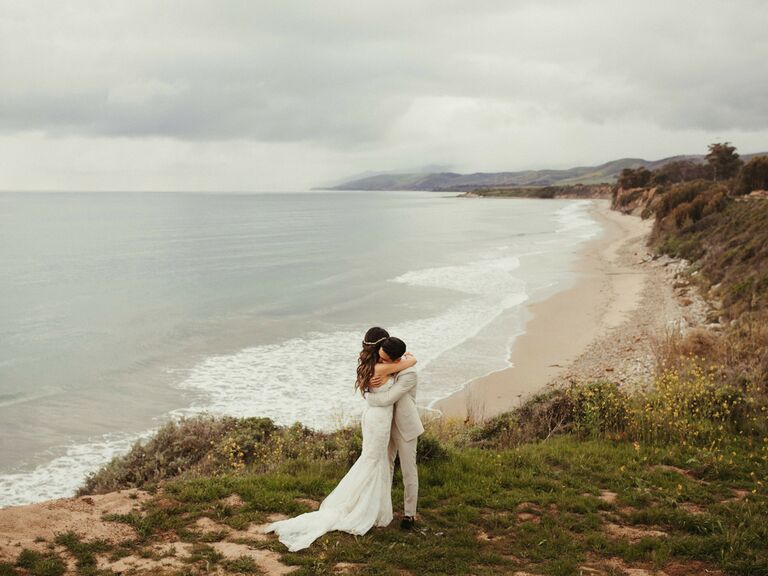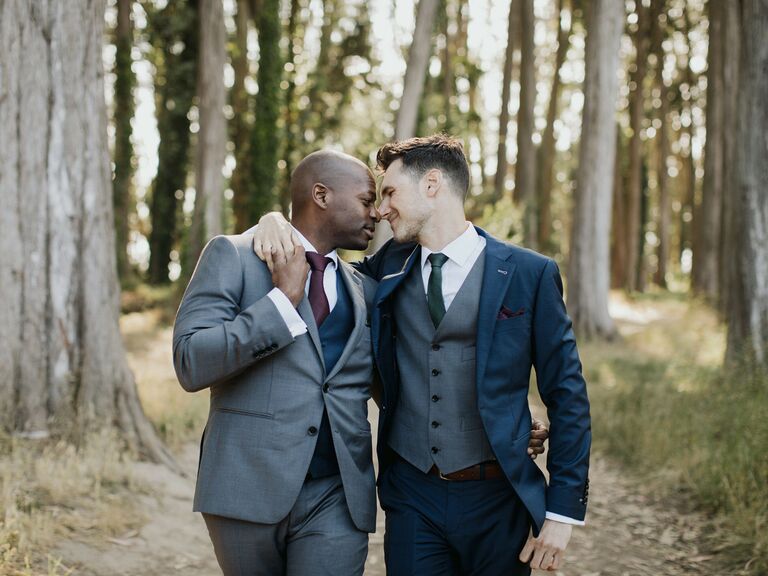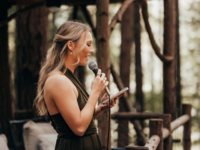How to Plan a Leave No Trace Elopement
In light of the coronavirus pandemic, many couples have pivoted their original plans of large gatherings to simple elopements in nature. And while exchanging vows outdoors is absolutely dreamy, it's important to be respectful of your surroundings. As such, we put together a guide on how to plan a "Leave No Trace" Elopement. The trend is inspired by Leave No Trace, an organization that provides research, education and initiatives so adventurers everywhere can enjoy and protect the world. (The site even has a Leave No Trace training course for elopement photographers everywhere so they can help minimize the event's impact on the surroundings.)
Leave No Trace Elopements are focused on eliminating any impact to the environment if you're exchanging vows outside—especially if your chosen venue is a national park. Since travel options are limited due to COVID, national and state parks have seen an exponential increase in visitors coming to explore. Couples everywhere are embracing the Norwegian concept of Friluftsliv, which focuses on getting outside and connecting with nature. But while exchanging vows outside is extremely romantic, it's important to protect our national parks. "National parks are there to preserve and protect the natural beauty of the area," says Alyssa Hillen, founder of Desert Rose Creative, a company that specializes in tiny weddings and elopments located in the Joshua Tree area. "They can be a gorgeous place to get married, but it's important to follow all of the rules because you don't want to might mess with the natural ecosystem and hurt the protected area."
To help you plan a responsible, eco-conscious elopement, we rounded up expert tips from pros who regularly plan weddings in nature.
What is a 'Leave No Trace' Elopement?
Just as the name suggests, a Leave No Trace Elopement is a ceremony that takes place outside (often at national parks) and causes little to no impact on the surrounding environment. That means no littering, no damage to nature and no disruption to the local wildlife.
It seems simple, but to successfully accomplish a Leave No Trace Elopement requires extra planning and care—but it's absolutely necessary, says Ann Kristin Nissen, wedding planner and manager at Brudepikenes (a company that specializes in outdoor weddings) in Norway. "When you borrow other people's things, you bring them back in the same condition as when you got it," she says. "It's the same when getting married in nature: When you are finished, you bring it back to the original state."
How to Plan a 'Leave No Trace' Elopement
But how exactly do you plan a Leave No Trace Elopement? We rounded up 10 expert tips to ensure your wedding respects and preserves the surrounding environment. "If you want to get married [in a national park], it's because you want that gorgeous, pristine, natural environment," says Georgia Hardingham, wedding coordinator at Mountainscape Weddings, a company that specializes in planning weddings in Banff National Park. "We need to ensure that the people after us, their kids and the people of the future also have that opportunity. We want these amazing places to be preserved for generations to come."
Plan Ahead
If you're getting married in a national park, plan accordingly. Many parks have rules on their websites, and it's important to familiarize yourself with them before the event. Scope out the boundaries of the wedding site, read about their animal policies (your furry friend might have to sit this one out) and call the ranger station and ask if you need a permit or any other special considerations for your celebration.
Additionally, think about the elements. Getting married outside (especially in a national park) means you need to prepare for inclement weather. Make a rain plan, bring appropriate shoes to get to your wedding site, and pack an emergency kit just in case. Hillen says many couples are shocked at how windy Joshua Tree can be, which is why we encourage you to ask your local planner or park ranger what the weather is like around the date of your wedding. That way, you'll be more prepared on the actual day.
Remember that bathrooms in national parks are typically shared portable toilets, so prepare for that on your wedding day. Additionally, it's crucial that you bring extra water to stay hydrated. We also recommend going to visit the park if possible to truly understand the lay of the land.
Planning ahead also ensures you only pack what you need, Nissen says. "The less you bring in, the less you need to bring out." Make a list and go over it thoroughly, asking if everything on it is a true necessity. If it's not essential, leave it at home.
Work With a Local Planner
Pros everywhere agree: Hiring a local planner is the key to planning a successful Leave No Trace Elopement. That's because pros in the area are extremely familiar with park guidelines and likely have lots of experience planning events and elopements. They'll be able to seamlessly organize the event and ensure you're as respectful to the environment as possible. (Psst: You can find a well-versed pro in the area over on The Knot.)



Stick to the Trails
It may be tempting to veer off the marked path, but Hillen says it's crucial you respect the rules. "Trekking off-trail can lead to some cool photos, but it can also damage the protected areas," she explains. Work with your photographer to find clearly marked areas where you can take epic wedding photos. Trust us, they'll still be absolutely stunning.
Only Bring the Essentials
The best part about eloping in nature is that the surroundings are already so beautiful. Whether you're exchanging views in a boho desert, a lush forest or a pretty garden, the scenery is guaranteed to be gorgeous. Not only is extra decor (think: arches or furniture) unnecessary, bringing it in can harm your surroundings.
Instead, focus on embracing the beauty already there. "Use nature gently as a prop instead of forcing elements that don't belong there," Nissen says. "By using nature as a backdrop, the couple will stand out as the main focus."
As for confetti? Leave it home, says Hardingham. "Whether it's biodegradable paper, rice or flower petals, it's garbage," she says. " If you want another option, try blowing bubbles or celebration streamers that guests wave as you walk for your recessional."
Be Respectful of Other Visitors
Remember that national parks are shared spaces. While you may have planned to get married in a specific spot, you need to be respectful of other visitors. "Bear in mind that nature is for everyone, and other visitors are allowed to be in the same area," Nissen says. "The nature is not your property, so you cannot do [whatever] what you want."
That means keeping loud noises or music to a minimum. Additionally, prepare for the possibility that other adventurers might need to pass through.
Keep Your Crew Small
While it may be tempting to include as many people as possible, Nissen says it's better for the environment (and also the pandemic) to keep your group small. "The more people, the bigger effect on nature—including the size of the event's carbon footprint," she says.
Dispose of Any and All Waste
"Pack it in, pack it out," Hillen says. That means anything you bring in, you must take with you. Don't leave any garbage behind, as litter damages the surrounding environment and puts local wildlife at risk. This includes any flowers you use on the wedding day.
One way to ensure you take care of any and all waste is to give the space a final walk-through once the event is over. You may be excited to get back home and celebrate, but this is a crucial step. "Thoroughly walk the wedding site (or designate a trusted person or wedding planner) after the wedding to ensure nothing is accidentally left behind," Hardingham says. "You don't want to unknowingly leave garbage."
And finally, remember that a national park is a shared space. We're all responsible for keeping them as clean as possible. "Clean up after others," Hardingham adds. " Even if it isn't yours, pick up garbage that you find on the site. Leave the space cleaner than when you arrived."
Respect the Local Wildlife
Whether you exchange vows in a far-off, hidden spot of a popular neck of the woods, you'll likely encounter wildlife. If any critters or creatures pass by your nuptials, give them space. Some animals can be dangerous in the wild, so do your best to ensure they don't feel threatened.
While it may be tempting to feed them, please don't. "The saying 'A fed animal is a dead animal can happen all too easily,'" Hardingham says. "Most of our food has sugar, salt and other additives that are unhealthy for our cute little critters."
Minimize Fire Danger
If you're planning a Leave No Trace Elopement, don't bring any fire hazards along with you. That means no smoke bombs, sparklers or candles. Pro tip: Many of these items are already banned at national parks, so if you do bring them in, you could be in trouble.
Some national parks have campsites where you can enjoy a bonfire. If you plan to do this for your elopement, talk with the park ranger about protocol and make sure it's completely put out before leaving.
Embrace the Adventure
While a Leave No Trace Elopement may be different than what you originally planned for your wedding day, it's important to embrace the adventure. "This year has shown that small, intimate weddings are a fantastic option for lots of people," Hardingham says. "We've worked with so many couples that had to downsize their weddings due to COVID, and the small wedding turned out to be more beautiful and special than they could ever have imagined."























